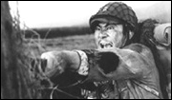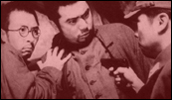Hoodlum Soldier
- Year
- 1965
- Original title
- Heitai Yakuza
- Japanese title
- 兵隊やくざ
- Director
- Cast
- Running time
- 105 minutes
- Published
- 20 March 2001



by Tom Mes
Hoodlum Soldier opens with a shot of the decomposed corpse of a Japanese soldier in the mud. It's an image that seems misleading, since this film is not about battles, death, and gunfire. Instead director Yasuzo Masumura recreates life in the barracks among Japanese infantry and artillery men stationed in Manchuria. Away from the battlefield (though always knowing they could be shipped off to fight any day), they spend their time bickering, brawling, and engaged in bitter rivalry with other army units. In Hoodlum Soldier army life becomes a miniature of version Japan itself. Men's lives are lived in daily repetition, lives in which duty and loyalty to the group mean everything, and hierarchy is an omnipotent force.
It's no coincidence that Masumura chose this approach to portraying the period. World War II was after all the last gasp of feudal, hierarchic Japan. In Hoodlum Soldier one gets the feeling that hierarchic Japan is like an entity, a master controlling the puppets that are the film's characters and that the master is trying to give his last and greatest performance before retiring into obscurity.
The film's two main characters are the only two people in the film who show any semblance of individuality: intelligent, but disillusioned pacifist sergeant Arita (Tamura) - a man who intentionally flunks his officer's exam so he can remain in the barracks and sit out his tour of duty, and Kisaburo (Katsu, star of the Zatoichi series), the hoodlum soldier of the title - a new recruit whose yakuza background makes him a tough nut to crack for his superiors. Their deviant natures make them different from their comrades, who are soldiers first and anything else only a distant second.
Masumura makes them the heroes of the tale. Through their rebellious nature they are extremely likeable (enhanced further by Kisaburo's burly, clumsy manner and Arita's cool intelligence) and audiences are behind the couple as they take on superiors and army rivals alike.
In the end, though, their individuality is no match for the army's (or society's) hierarchic structure. In fact, their struggle was futile from the start, since the bond between these two men was a product of army hierarchy in the first place: upon the hoodlum soldier's arrival, his superiors (knowing full well of his benevolent nature) ordered the sergeant to watch over the new recruit and keep him out of trouble.
And just as the individualist natures of the two lead characters are powerless against the hierarchy, the battles of wills, power games, and fights for honour among the soldiers in the barracks also amount to nothing. They will find their end on the battle field, where they die with the soldiers who fight them. And that's when we realise that that opening shot of the skeleton was not an opening shot at all, but a dark vision of the soldiers' inescapable future.
Daiei studios released a sequel to Hoodlum Soldier the same year, following the further adventures of Kisaburo and Arita. However, this and subsequent episodes (the series ran eight in total between 1965 and 1972, with only the first and last instalments directed by Masumura) discarded the thematic richness of the original and focused instead on the rapport between the two lead characters (played by Katsu and Tamura throughout).